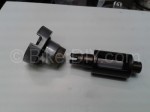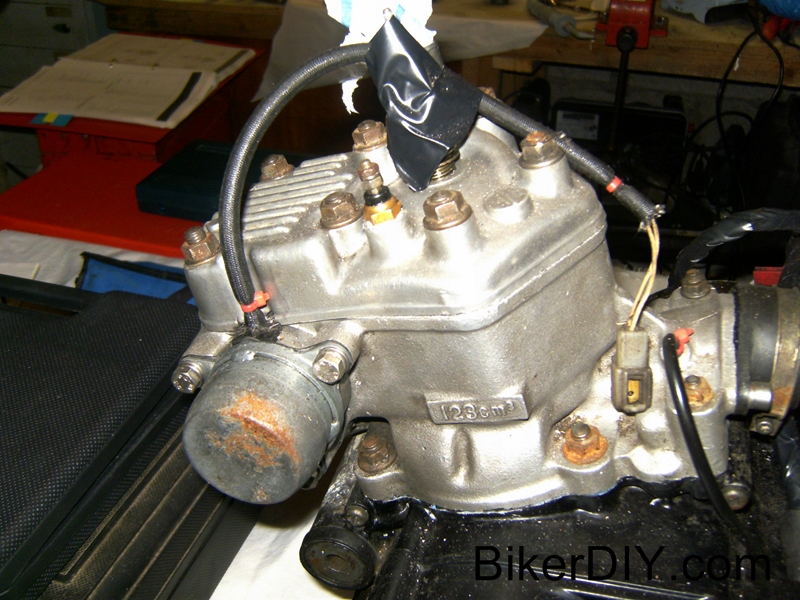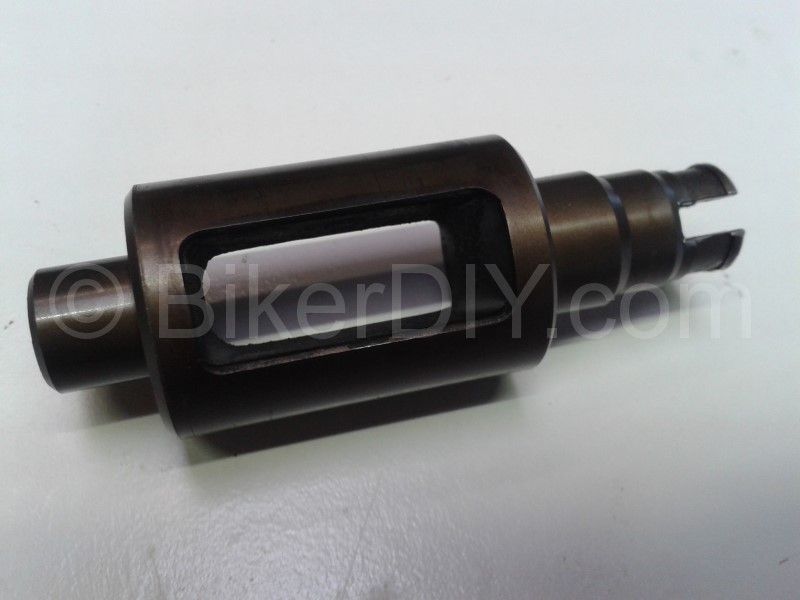
Apparently I was lucky in that I have an rgr125 Gamma engine that came with a still operating power valve. But that was less to do with luck and more because “back in the day” in Ireland, learner legal bike restrictions where mainly based on engine size (less than 127cc I think), and not engine performance, so the Gamma was legal on an A1 learner permit. However I have learned since I started this project that in some parts of the world (the UK for example), the learner legal requirements where for specific power and so quite a lot of Gamma’s where sold in those countries minus the power valve, and with just a blanking plate where the power valve solenoid and collar should be.
Just to give a brief explanation of the workings of this valve, and I mean what it does not how it does it, as I am aware of it’s effect but I don’t pretend to understand the details of 2 stroke exhaust tuning. Basically there is a chamber built into the front of the head of the rgr125 Gamma engine above the exhaust port. In my bike a valve controls the opening into this chamber from the exhaust port. When the engine is running at low rev’s (sub 6,750 or so) the valve is open allowing the exhaust gases to expand into this chamber as well as into the exhaust. This maximises the power output of the engine at these RPM’s, and this is also how a non power valved engine would perform at low rpm’s as it also has this chamber open to it.
But then once the engine rpm’s get above about 7,400 or so a box of electronics drive the solenoid to close the valve, shutting off the chamber from the exhaust system which returns the exhaust tuning to a more optimum set up for power generation at these higher rpm’s and giving the rider a big old smile at the same time. Unless of coarse your on the one with no power valve which means the chamber is still open to the exhaust, throwing the exhaust tuning and as such is seriously hampering the power output of the engine. You might see in the video below the difference in engine response at the valve switch point.
Now I myself have never ridden a Gamma without the working valve but given it was done to reduce the maximum power generated by the engine then I would imagine it would be less fun than riding one with it. And in support of my thinking it would seem many power valve-less Gamma riders on-line are quite keen to rectify the situation and gain back that untapped power from the engine.
Apparently a popular relatively low tech way to “fix” the set up is to fit a tube or bar into where the valve should be so as to block the aperture to the chamber permanently. This in effect gives back the power at the higher RPM’s, but at the cost of power at the lower RPM’s, which in fairness is already poor enough. I am going to assume that if you fit one of these tubes then you spend all of your time in the over 7,000rpm range. Which might have, all on it’s own, lead to a certain opinion of 2 stroker riders.
Anyway, from all of that came requests about the place from Gamma owners about dimensions and drawings, so that individuals could either fabricate a switchable valve or at least a tube/bar to fit the space and close off the chamber. So I thought I’d put together a diagram of the valve off my Suzuki 1988 model Rgr125j Gamma so that people had some idea of what they might need. So here it is.
As before, I feel the need to excuse myself as a complete DIYer when it comes to creating tech drawings, but I think I have captured all the relevant info. And just so you can see it, here is the much coveted item in the flesh.
If there is more info I could provide or something I have gotten wrong then please let me know in the comments and I’ll do what I can to add/rectify it as quick as I can.






Great write up, I’m one of the type you mention who is looking to recreate the system, but luckily I have a full power bike also which I can in theory copy. You’ve saved me some work with the cad hopefully tho, so thanks !
Cheers for that. And cheers for taking the time to leave a comment. I’m always glad to hear someone has got something of use from a post. Best of luck with the PV system. As I’m sure you know more than I (what with having the 2 gammas) it will be well worth it.